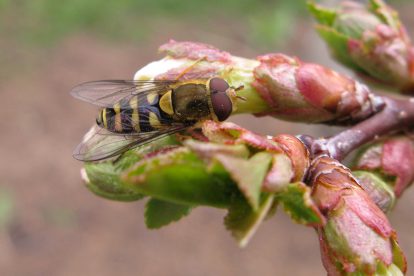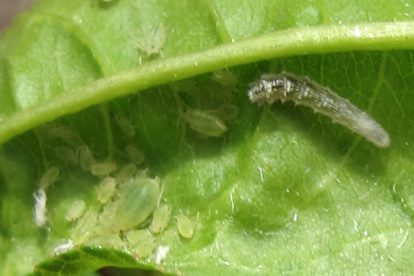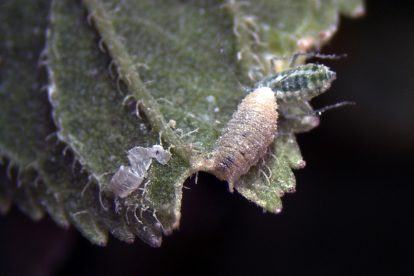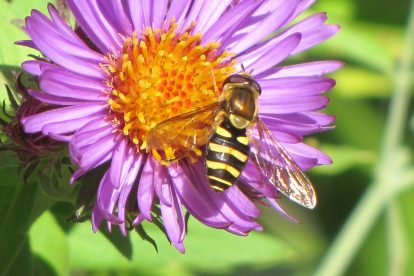In this Issue:
- Apple, Pear: codling moth dates available; fire blight warnings
- Peach/Nectarine, Apricot, Plum: peach powdery mildew and coryneum blight fungicide at shuck split stage; peach twig borer spray dates for southern Utah; greater peachtree borer
- Beneficial Spotlight: syrphid flies
APPLE, PEAR
Codling Moth
egg hatch prediction dates provided for some locations
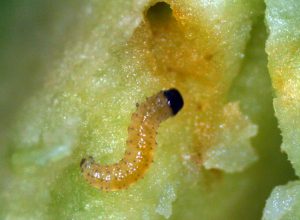
View a pdf of the spray timing table. Be sure to read the instructions at the top of the page, for how to read the table.
Codling moth treatment timing is coming up in late-May for many areas of northern Utah. We will provide information about the remaining locations toward the end of next week.
Be prepared, because this is a pest that you need to prevent all season long for clean fruit. Whether you are growing organic or conventional, the only non-spray option for clean fruit is to bag them (click here and here for more info on bagging fruit.)
Options for commercial growers.
Options for residential growers (scroll down to Codling Moth heading and see table).
For strategies on how to deal with spray applications, it will depend on whether you are using organic options, or if you historically have a high or low population of codling moth to deal with.
- Conventional production options
- High damage: Apply first application at “start date.” Repeat 14 days later for a total of 2 applications in the first generation. When the “start date” for the 2nd generation is provided, spray every 10-18 days until Sept. 15. Pick a different product to use for each generation.
- Low damage: Apply an application at “start date.” Wait until the “start date” for the 2nd generation is provided, and spray on that date, and again 14 days later. Do the same for the 3rd generation. Pick a different product to use for each generation.
- Organic production options (other than bagging)
- High damage: Apply first application at “start date.” Repeat 7-10 days later for a total of 3 applications in the first generation. When the “start date” for the 2nd generation is provided, spray every 7-10 days until Sept. 15. Pick a different product to use for each generation.
- Low damage: Apply first application at “start date.” When the “start date” for the 2nd generation is provided, spray every 10-14 days until Sept. 15. Pick a different product to use for each generation.
Fire Blight
infections may happen on blossoms in warm, wet weather
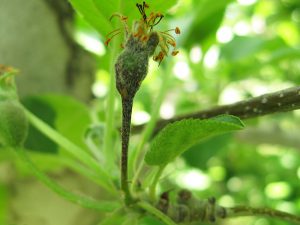
Fire blight is a bacterial plant disease that causes infections through open flowers on apple and pear (plus other ornamentals such as crabapple and hawthorn). Infections occur during warm, wet days. We use a model called Cougarblight to estimate fire blight risk, from LOW to EXTREME.
- Utah, Cache, Iron, County, Cache County, Cedar City (areas of average temperature such as closer to I-15): HIGH risk through tomorrow (May 7).
- Salt Lake, Davis counties: HIGH to EXTREME risk through May 9
- Weber, Box Elder counties: HIGH risk though May 8
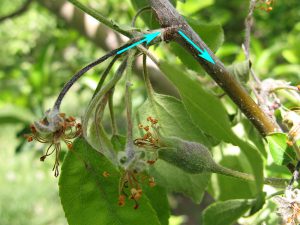
(Locations not listed above either have lower risk, or flowers are not in bloom.)
A chance of rain is expected Tuesday and Wednesday (May 7-8), so an antibiotic application may be warranted on the most susceptible varieties.
You can watch fire blight predictions on the Utah TRAPs website by selected a location closest to you, and then selecting Fire Blight in the ‘Pest’ drop-down.
For commercial producers, most areas (except the southern part of Utah County, which has resistance) can use streptomycin. Where resistance occurs, producers should use oxytetracycline (MycoShield) or Kasumin. One application can be a mix of oxutetracycline and streptomycin.
Most diligent backyard growers should not need to apply an antibiotic. (Although if necessary, most garden centers carry streptomycin.) Instead, monitor trees closely starting two weeks after full bloom (which is when infections start to become visible). Prune out new infections immediately (on a dry day).
PEACH, NECTARINE, APRICOT, PLUM
Peach Powdery Mildew
apply fungicide at shuck split stage
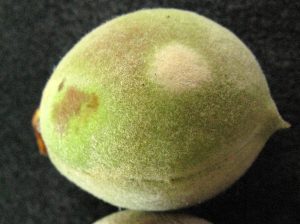
There are two fungal species that cause powdery mildew (PM) on peach. One is specific to peach (Sphaerotheca pannosa), affecting the foliage and fruit, and the other is apple powdery mildew (Podosphaera leucotricha), that only affects the fruit.
Peach PM overwinters on roses and sometimes on peach buds and bark. In spring, when nights are cool and moist, and days are warm, spores infect foliage (rarely) and peach fruitlets. On fruit, new lesions look like fuzzy, bright white spots. Fruit infections can occur all spring until the pit hardening stage. (The only way to tell pit-hardening is to slice peaches.) Infections on leaves are typically only seen later in the season.
Apple PM on peach is referred to as “rusty spot.” The fungus overwinters on apples only, and fruit of peach trees grown near apple trees with PM may be affected. On peach fruit, new lesions look pale whitish at first, and within a few days, the skin under the infection takes on a rusty-orange streaking.
Infections of either disease won’t be noticeable on fruit until 2 to 4 weeks after bloom. At that time, monitor 25 fruits on several trees for the presence of round, whitish, powdery spots on the fruit surface. A total of 10 to 20 fruit infections and greater than 20 fruit infections per tree represents moderate and high risk, respectively.
Susceptible varieties include Redskin, Rio Oso Gem, Elegant Lady, Fairtime, Fay Elberta, and Summerset.
Peach powdery mildew can be prevented with a shuck-split or shuck-fall fungicide application.
Find options for commercial growers by clicking here.
In residential settings, fruit that was infected is still edible to eat. If aesthetics is a concern, chlorothalonil or sulfur (organic) can be used (and will also help manage coryneum blight) at the shuck split stage. If a fungicide is needed after shuck split, use sulfur or Spectracide Immunox.
Continue fungicide sprays on susceptible varieties at 10 to 14-day intervals until the pit hardening stage is reached.
Coryneum Blight
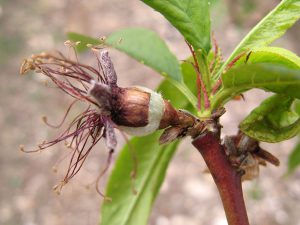
apricot, peach – fungicide application at shuck split stage
If coryneum blight is a problem on your peach, nectarine, or apricot trees, note that one of the most important times to apply a fungicide is after bloom, at the shuck split stage (see more images under “Coryneum Blight” on this post.).
This pathogen is spread primarily by rain, and optimal conditions for infection are when temperatures are from 70 to 80°F.
Commercial growers can find options by clicking here.
Backyard growers can use one of the following:
- Spectracide Immunox
- product containing chlorothalonil (Daconil, for example. Note that chlorothalonil cannot be used after shuck split while fruit is still on the tree.)
- Captan
Peach Twig Borer
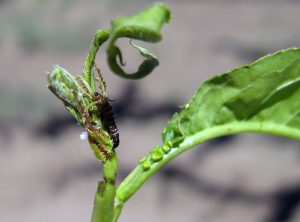
peach, nectarine, apricot – spray dates for some areas of southern Utah
Peach twig borer is active in the warmest southern Utah locations. This pest prefers to feed inside succulent peach shoots, but later in the summer, it feeds inside the fruits themselves. It is best to knock the population down early rather than waiting until later.
Application timing dates (apply anytime in this range):
- Hurricane and Zion’s Canyon area: May 16 – 19
- Leeds: May 15 – 18
- St. George: May 10 – 13
Greater Peachtree Borer
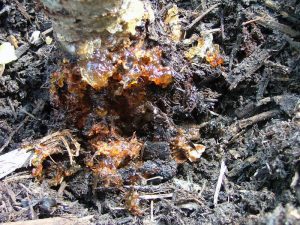
peach – kill exposed larvae; wait on insecticide application
Greater peachtree borer is another pest that we monitor with pheromone traps. Our traps are up in orchards in Utah, but none have been caught in either northern or southern Utah.
Also known as trunk borer or crown borer, this pest is making itself known this spring. It overwinters as a larva inside the lower trunk of peach trees, and starts feeding under the bark again in spring. The tree’s defense mechanism is to push out the larva with copious, gummy sap from the base of the tree. Sometimes several larvae can be found within the sap. If the larvae survive, they pupate to a moth, and then later, females lay eggs on the lower trunk.
This pest is managed by spraying the lower trunk of the tree (and any exposed roots) to prevent larvae from entering the tree. Young trees are especially vulnerable, and can be killed in one season, while older trees can usually withstand a few attacks.
We will provide an alert for this pest in a future advisory, but the typical start time for treatment is June 15 for northern Utah and May 15 for southern Utah.
Residential growers can use a product containing permethrin on peach only (such as Hi Yield Indoor/Outdoor or Lawn, Garden, Pet, & Livestock, or Bonide Eight).
OTHER INFORMATION
Beneficial Spotlight – Syrphid Flies
Syrphid flies, also called hover flies, resemble honey bees in their coloring, but have only one pair of wings. There are hundreds of species of syrphid flies that occur in the western U.S. Adults are pollinators, visiting a wide variety of flowers to feed on nectar and pollen.
Their young (larvae) feed almost exclusively on insects. They prefer aphids, but also consume spider mites, scales, leafhopper nymphs, and other small insects and eggs.
Syrphid flies have several generations per season, but their activity slows down during the hottest summer months.

